You are in bear country
Kluane National Park and Reserve
SAFE TRAVEL IN BEAR COUNTRY
The Yukon and Northern British Columbia are home to grizzly and black bears
You can run into a bear anywhere: in a campground, on a busy trail or in the remote backcountry. While bears generally prefer to avoid people, encounters do occur.
Bears are extremely sensitive to human activity. Avoiding bears helps to protect them. Learning how to prevent bear encounters is the best way to enjoy our national parks and historic sites safely.
If you do encounter a bear, it is important to understand bear behaviour. How you respond in an encounter depends on the type of interaction that is taking place. The video “Staying Safe in Bear Country” is highly recommended and is available for viewing at Parks Canada visitor centres.
AVOID an encounter: the best approach- Make noise!
Let bears know you are there. Call out, clap hands,sing or talk loudly, especially on windy days, and when in bears’ preferred habitats like streams and berry patches, and in areas of low visibility. Bear bells alone are not enough. - Be observant
Travel in daylight and look around as you travel. Watch for bears and bear sign, e.g., tracks, droppings, diggings, torn-up logs or turned-over rocks. Leave the area if the signs are fresh. If you come across a large animal carcass, leave the area immediately and report it to park staff. - Keep your dog on a leash
Dogs can provoke defensive behaviour in bears. In national parks and historic sites owners must keep pets under physical control at all times. - Travel in groups
Larger sized groups are more obvious and intimidating to bears, so are less likely to have a serious encounter. Never let children wander. - Minimize attractants
Dispose of waste in bear-proof garbage cans. Keep your pack with you at all times. Fish offal may be disposed in fast-moving streams or the deep part of a lake. Never leave fish offal on the shore. - Respect area closures
Do not hike or camp in closed areas. Closures are often in response to increased bear activity.
For information on polar bears in Northern Yukon, see Parks Canada's "Safety in Polar Bear Country" (PDF, 2.02 Mb) brochure.

© H. Fitzgerald
DETERRENTS

© N. Pritchett
Carry bear spray with you at all times
Bear Spray is effective when used properly. Be aware that wind, spray distance, rain, freezing temperatures and shelf life can all influence the spray’s effectiveness. Familiarize yourself with the manufacturer’s instructions for your bear spray, and carry it where you can access it at a moment’s notice.
Other tools can help you deter a bear: noisemakers such as air horns and rattles, non-lethal projectiles and electric fencing.
Firearms are not permitted in national parks or historic sites in Canada
Plan ahead. Bear spray and other deterrents may not be available for purchase in smaller communities in the Yukon, and are strictly prohibited from travel on commercial airplanes. Check with border services about transporting deterrents across national borders.
REPORT BEARS
PLEASE REPORT ALL BEAR SIGHTINGS AND INTERACTIONS
Bear observations
Visitor reports of bear observations are very important information for bear management within Kluane National Park and Reserve and Chilkoot Trail National Historic Site.
Key information: number, species and colour/description of bear(s), location (GPS coordinates if possible), distance from observer, bear’s behavior, observer’s contact information.
Kluane: fill out a Bear Observation Form(available from the Kluane National Park and Reserve visitor centres) or call 867-634-7250.
Chilkoot Trail: fill out a Bear Report Form(available at the Trail Centre in Skagway, Lindeman Camp) or tell a Parks Canada staff person along the trail.

© T. Buzzell
Emergencies:
Parks Canada 24-hour emergency line:
1-780-852-3100 / 1-877-852-3100 (toll-free)
IF YOU SEE A BEAR
Stop and remain calm. Do NOT run away. Pull out your bear spray. Assess the situation:
Is the bear UNAWARE of your presence?
- Move away quietly without getting its attention
Is the bear AWARE of your presence?
- Stay calm
Your calm behaviour can reassure the bear. Screams or sudden movements may trigger an attack. - Speak to the bear
Talk calmly and firmly. This lets the bear know you are human. If a bear rears on its hind legs and waves its nose about, or circles to get upwind of you, it is trying to identify you by sight or scent. - Back away slowly
DON'T RUN! Running may trigger a pursuit. - Make yourself appear BIG
Pick up small children and stay in a group. - Do not drop your pack
It can provide protection.
If you must continue on your planned route, make a wide detour around the bear or wait at a safe distance for it to move on.
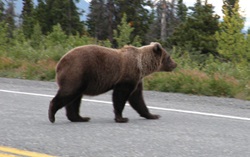
© N. van Vliet
Roadside Bears
- Stay inside your vehicle; keep windows up.
- Consider not stopping: bears habituated to vehicles and people can become a problem.
- Remain a respectful distance away from the bear and don't interfere with natural behaviours.
IF THE BEAR APPROACHES
Stop and remain calm. Do NOT run away. Pull out your bear spray. Assess the bear's behaviour and determine WHY it is approaching.
Is it DEFENSIVE?
The bear may be feeding, protecting its young and/or surprised by your presence. It may see you as a threat.
The bear will appear agitated and may vocalize by woofing, growling, moaning, huffing and/or snapping its jaws. Its ears may be laid back and it may jump forward, slap the ground or swat nearby objects.
Defensive bears may bluff by charging and then turning away at the last second.
- Try to appear non-threatening. Avoid eye contact.
- Talk in a calm voice.
- When the bear stops advancing, start backing away slowly.
- If there are cubs in the area, move away from them. Never be between a mother and her cubs.
- If the bear keeps coming closer, stand your ground, keep talking.
- If the bear comes within range of your bear spray, spray it!
Is it NON-DEFENSIVE?
The bear may be curious, after your food, or testing its dominance. In the rarest case, it might see you as potential prey. All of these non-defensive behaviours can appear similar, and may include following you.
Curious bears approach hesitantly, with ears cocked forward, and head and nose raised to investigate. They may circle to move downwind of your scent. Bears seeking food or testing dominance may approach more boldly. A predatory bear would have a confident and persistent approach, and would be intensely focused, with head up and ears erect.
- Talk in a firm voice.
- Move out of the bear’s path.
- If the bear follows and stays intent on you, stop and stand your ground.
- Make yourself appear large, move uphill and stand on a log or rock.
- Shout and act aggressively, and threaten the bear with anything you can find.
- If the bear comes within range of your bear spray, spray it!
HANDLING AN ATTACK
Attacks are rare. If a bear makes contact, your reaction will depend on the type of attack.
DEFENSIVE
The most common type of attack, this may happen as a surprise encounter at a a close distance. The bear is defending itself, its food source or its cubs.
At or just before the moment the bear strikes you, fall to the ground and PLAY DEAD.
PLAY DEAD!
- Lie on your stomach with legs apart and lock your fingers behind your neck. Protect your face and vital organs. If the bear flips you over, roll back onto your stomach.
- Don't cry out or fight back.
- Remain still until you are sure the bear has left the area.
Defensive attacks are generally less than two minutes long. Once the bear no longer thinks you are a threat it will stop. If the attack continues, the bear's motivation has likely shifted from defensive to predatory.
REMEMBER...the best strategy for bear attacks is to avoid encounters in the first place!
PREDATORY
In this very rare type of attack, the bear sees you as prey.
Try to escape into a building, car or up a tree; keep in mind that black bears are particularly good climbers. If you cannot escape, FIGHT BACK!
FIGHT BACK!
- Use any weapon you have.
- Be as aggressive as you can.
- Concentrate your fight on the bear's face.
- Don't give up.

© S. Davidson
BEAR RESISTANT FOOD STORAGE
Proper food storage is one of the best ways to prevent conflicts with bears.
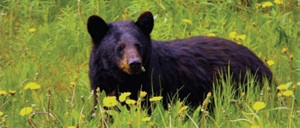
© S. Davidson
If bears get into human food, they will continue to seek it. Such "food-conditioning" is a primary cause of bear-human conflict. Using certified bear-resistant food storage is one of the best ways to prevent such conflicts.
A list of certified bear-resistant products can be found at the Interagency Grizzly Bear Committee website.
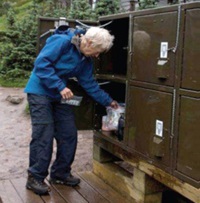
© M. McLean
Chilkoot Trail National Historic Site
- All food and garbage must be stored in the bear-resistant food lockers provided at each campground.
- When hiking, do not leave packs unattended.
Kluane National Park and Reserve
- Use of a certified bear-resistant product is required for all overnight back-country trips.
- In Kathleen Lake campground, food must be secured in vehicles or stored in the bear-resistant food lockers on site.
- Rafting groups on the Alsek River are required to follow the food storage procedures outlined in the Alsek River Guidelines
Vuntut National Park
- Certified bear-resistant canisters are strongly recommended for all overnight trips.


© S. Donker
SAFE BACKCOUNTRY CAMPING
Limit your impact by avoiding bear encounters and managing your food, garbage and associated odours.

- Camp, cook and eat in designated areas when provided.
- Avoid camping, cooking or eating near areas that are frequented by animals: running water, thick brush, animal trails or berry patches.
- If camping in non-designated sites, set up your cooking, eating and food storage areas at least 50 metres downwind from your tent. Ensure good visibility.
- Minimize odours. Leave scented toiletries at home. Plan meals carefully: bring low-odour dried or pre-packaged foods and minimize waste.
- Immediately upon arrival in camp, store food, pet food, garbage and toiletries in bear-resistant containers. Or, where provided, use food-storage facilities.
- Never have food in your tent! Keep yourself and your gear odour free-and after eating change into odour-free sleeping clothes.
- Wash and store all dishes and utensils immediately after use. Strain food particles from dishwater and store with garbage. Dump dishwater in designated areas if provided, or at least 50 metres from your sleeping area.
- Pack out garbage-do not burn or bury it and do not dispose of it in privies.

© R. Edelman
GRIZZLY OR BLACK BEAR?
Individuals of both species can range in size and colour. The most reliable way to identify the species is to look for distinguishing features:
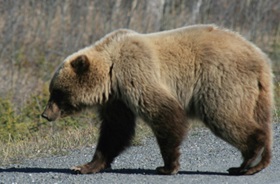
© N. Pritchett
GRIZZLY BEAR - Also known as "Alaskan Brown Bear"
- Fur can be blonde, red, dark brown or black
- Adult males weigh about 250kg (550lbs) and females 150kg (330lbs)
- Evolved in more open habitats: today live in both open and forested habitats
- Front claws are long and specialized for digging
Notice:
- large head
- distinct shoulder hump
- short, rounded ears
- scooped snout profile
- long claws
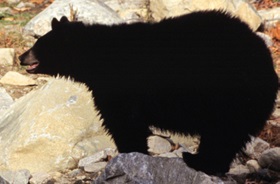
BLACK BEAR
- Fur can be blonde, grey-blue, brown or black
- Adult males weigh about 135kg (300 lbs) and females 70kg (150 lbs)
- Evolved in forested habitats: are agile climbers
- Diet is up to 90% vegetation, berry crops are a critical food source
Notice:
- small head
- no shoulder hump
- tall ears
- flat snout profile
- short claws
- Date modified :
